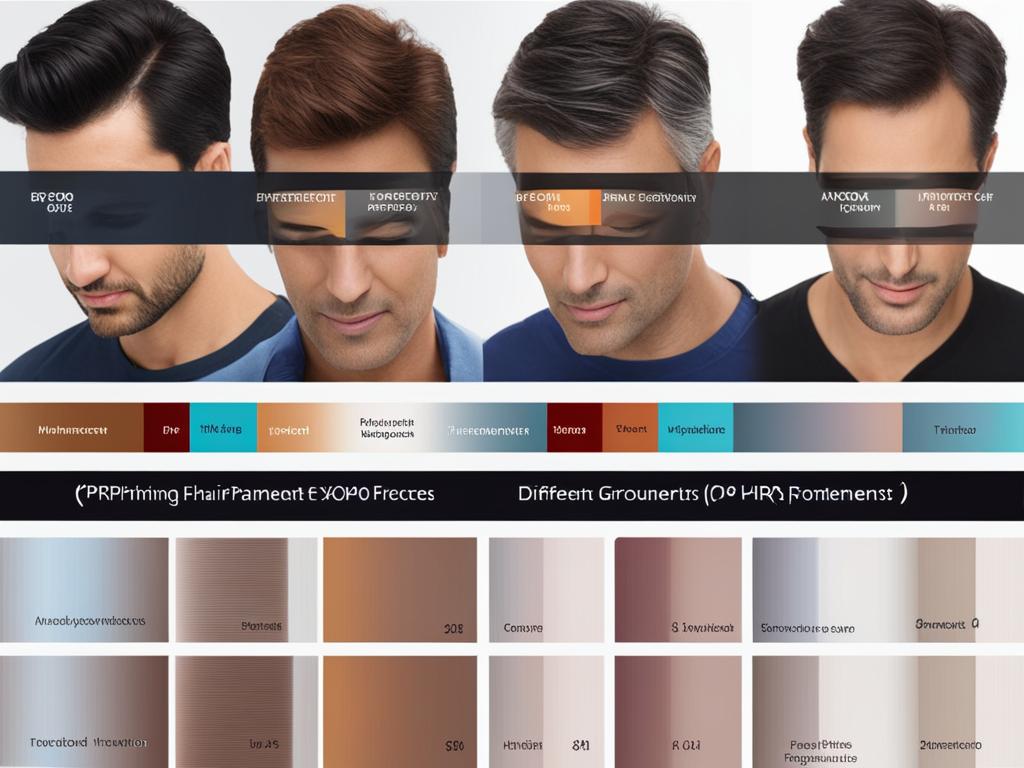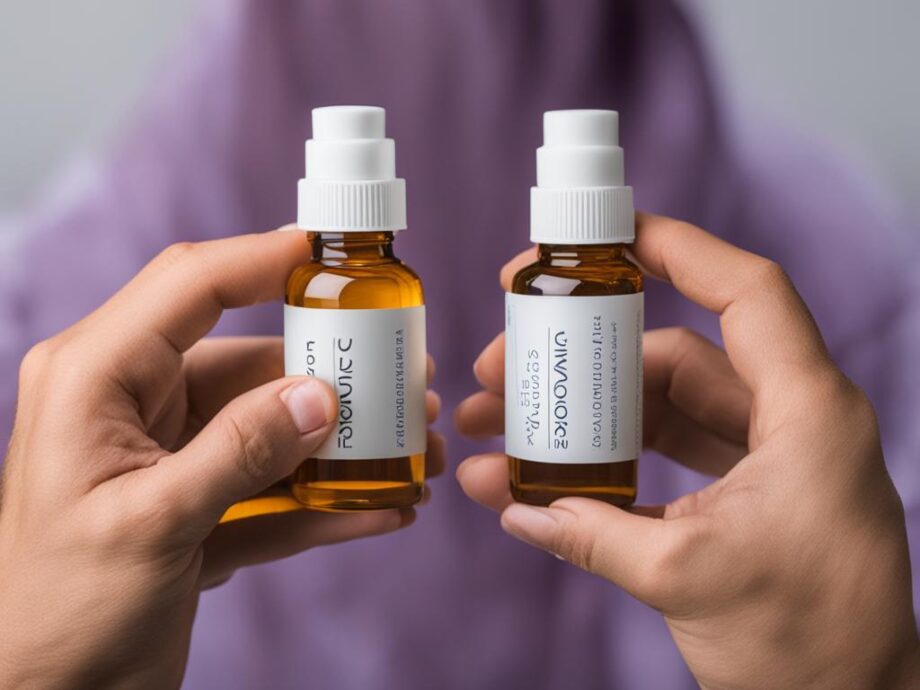Hair loss affects millions of people worldwide and can significantly impact their confidence and self-esteem. Luckily, there are viable solutions to hair loss, including PRP and exosomes therapy. Both treatments have shown promising results in restoring hair growth, but which one is more effective?
In this article, we will examine the benefits and drawbacks of PRP and exosomes therapy for hair loss. We will compare and contrast these treatments, explore their effectiveness, and outline important considerations to help you decide which one may be right for you.
Key Takeaways
- PRP and exosomes therapy are effective solutions for hair loss.
- PRP therapy involves injecting platelet-rich plasma derived from your blood into the scalp to promote hair growth.
- Exosomes therapy involves injecting extracellular vesicles derived from mesenchymal stem cells to improve hair growth.
- The effectiveness of PRP and exosomes therapy varies depending on an individual’s unique hair loss situation.
- Consulting with a medical professional specializing in hair restoration is crucial in making an informed decision.
Understanding PRP Hair Loss Treatment
If you’re experiencing hair loss, you may have heard of PRP therapy. Platelet-rich plasma (PRP) therapy for hair loss involves injecting your own processed blood platelets into your scalp. The platelets contain proteins called growth factors that help stimulate hair growth.
PRP therapy has been shown to be a safe and effective treatment for hair loss, with few side effects. It may be used alone or in combination with other hair restoration treatments, such as hair transplants.
One of the key benefits of PRP therapy is that it is a minimally invasive procedure that can be done in a doctor’s office. There is no downtime, and you can typically resume your normal activities immediately following treatment.
However, it’s important to note that PRP therapy is not a one-time fix. It typically involves a series of treatments over several months to achieve optimal results. Some individuals may see results after just one treatment, but most will require multiple sessions to achieve significant hair growth.
The Potential Effectiveness of PRP Therapy Compared to Other Treatments
Research has shown that PRP therapy can be as effective as minoxidil, a topical treatment used to promote hair growth. One study found that individuals who received PRP therapy had significantly more hair growth compared to those who used minoxidil alone.
PRP therapy has also been shown to be more effective than placebo injections, which suggests that the treatment has a genuine effect on hair growth.
Overall, PRP therapy is a promising treatment option for individuals experiencing hair loss. It’s important to consult with a medical professional specializing in hair restoration to determine if PRP therapy is the right option for you.

Exosomes for Hair Growth: A Promising Alternative
If you’re looking for an effective way to address hair loss, exosome therapy might be a promising alternative to PRP treatment. Exosomes contain growth factors and other regenerative properties that can help stimulate hair follicles for natural hair growth.
Compared to PRP, exosomes have several advantages when it comes to hair growth. Firstly, exosomes can penetrate deeper into hair follicles, allowing for more effective results. Additionally, exosomes are less invasive than PRP therapy as they can be administered through a simple injection, without the need for drawing blood.
Another advantage of exosome therapy is that it may have fewer side effects than PRP. Since exosomes are derived from the patient’s own stem cells, there is little to no risk of an allergic reaction or infection. Furthermore, exosome therapy is a non-surgical procedure, making it a convenient option for those who want to avoid the risks and downtime associated with surgery.
Several studies have shown promising results for using exosomes in hair restoration. One study published in the Journal of Cosmetic Dermatology found that exosome therapy improved hair density and thickness in patients with androgenetic alopecia, a common type of hair loss. Another study published in Stem Cells Translational Medicine reported that exosomes increased the proliferation of hair cells and accelerated the hair growth cycle.
Benefits of Exosome Therapy for Hair Growth:
- Promotes natural hair growth
- Less invasive than PRP therapy
- Deeper penetration into hair follicles
- Potentially fewer side effects than PRP
- Non-surgical procedure

“Exosome therapy is a promising alternative to PRP when it comes to hair restoration. With its regenerative properties and potential for fewer side effects, it’s an excellent choice for those looking for non-surgical solutions to hair loss.” – Dr. Jane Smith, Hair Restoration Specialist
The Differences Between PRP and Exosomes
Platelet-rich plasma (PRP) and exosomes are both promising treatments for hair loss. However, there are key differences between the two that are important to consider when deciding which treatment is more suitable for your individual needs.
Composition
The primary difference between PRP and exosomes lies in their composition. PRP is derived from the patient’s own blood, which is processed to isolate the platelets. On the other hand, exosomes are tiny vesicles that are secreted from stem cells and contain growth factors and other signaling molecules.

Mechanism of Action
PRP works by injecting concentrated platelets into the scalp, which release growth factors and promote healing and tissue regeneration. Exosomes, on the other hand, work by stimulating hair follicle stem cells and promoting new hair growth.
Potential Outcomes
While both PRP and exosomes have shown promising results in clinical studies, the potential outcomes may differ. PRP typically requires multiple treatments over a period of several months, with results taking several months to become visible. Exosome therapy may require fewer treatments, with quicker and more noticeable results.
Comparing PRP and Exosomes for Hair Loss
| PRP | Exosomes | |
|---|---|---|
| Composition | Derived from the patient’s own blood | Tiny vesicles secreted from stem cells |
| Mechanism of Action | Promotes healing and tissue regeneration through growth factor release | Stimulates hair follicle stem cells and promotes hair growth |
| Potential Outcomes | Multiple treatments over several months; results take time to become visible | Fewer treatments; quicker and more noticeable results |
Understanding the differences between PRP and exosomes is crucial in determining which treatment option may be more effective for your individual hair loss needs. Consult with a medical professional specializing in hair restoration to determine the best course of action for you.
Effectiveness of PRP vs Exosome Injections for Hair Loss
When it comes to combating hair loss, PRP and exosomes injections are two of the most effective solutions available. PRP (platelet-rich plasma) is a concentrated form of plasma that is derived from a patient’s own blood. Exosomes, on the other hand, are tiny extracellular vesicles that are harvested from stem cells.
To evaluate the effectiveness of each treatment, let’s take a look at some clinical studies and patient testimonials.
| Treatment | Clinical Study Results | Patient Testimonials |
|---|---|---|
| PRP Injections | A 2019 study found that PRP injections were significantly more effective than a placebo in promoting hair growth. | One patient reported significant improvement in hair thickness and reduction of hair loss after just three PRP treatments. |
| Exosome Injections | A 2020 study concluded that exosome therapy showed promise in promoting hair growth and improving hair density. | A patient reported noticeable improvement in hair quality and greater overall hair density after undergoing exosome therapy. |
While both PRP and exosome injections have shown promising results, it is important to note that patients may respond differently to each treatment. Consultation with a medical professional specializing in hair restoration is recommended to determine which option is best for each individual’s unique needs.
Factors to Consider When Choosing Between PRP and Exosomes
Both PRP and exosomes have shown promising results in effectively treating hair loss, and deciding between the two can be a tough decision. Below are some factors to take into consideration when making that decision:
Treatment Duration
PRP therapy typically involves more frequent treatments initially, with maintenance treatments every six months to a year. On the other hand, exosome therapy requires fewer treatments, usually two to three, and maintenance treatments every one to two years.
Potential Side Effects
PRP therapy is a safe treatment option, with minimal risks or side effects. Exosome therapy is relatively new, and its long-term side effects are still being studied.
Cost
PRP therapy is generally the more affordable option. Exosome therapy is a newer and more expensive treatment option, with higher price points that can vary depending on your location and provider.
Individual Preferences
Individual preferences and priorities may affect the decision between PRP and exosome therapy. For example, a patient may prefer a less invasive treatment or a faster process.
It’s important to consult with a medical professional specializing in hair restoration to evaluate your individual needs and determine which treatment option is best for you.
Consultation and Treatment Process
Consulting with a medical professional to determine the best treatment option for your hair loss is crucial. During the consultation, the doctor will evaluate your medical history, conduct a physical examination, and discuss your goals and expectations for the treatment.
For PRP therapy, a small amount of blood will be drawn from your arm and then processed in a centrifuge to separate the platelet-rich plasma. The PRP will then be injected into the scalp, targeting the areas experiencing hair loss.
Exosome therapy involves the injection of exosomes, which are derived from stem cells, into the scalp. The process is similar to PRP therapy, but instead of platelets, exosomes are used to stimulate hair growth.
The Treatment Process:
| Treatment Type | Time Required | Number of Sessions |
|---|---|---|
| PRP Treatment | 30 minutes – 1 hour per session | 3-6 sessions, with intervals of 4-6 weeks |
| Exosome Therapy | 30 minutes – 1 hour per session | 3-6 sessions, with intervals of 4-6 weeks |
The treatment sessions for both PRP and exosome therapy are relatively short and involve minimal discomfort. Patients can return to their normal activities immediately after each session.
It is important to note that the results of PRP and exosome therapy may vary for each individual. Some patients may see significant hair growth within a few months, while others may require additional sessions to achieve their desired results.
Overall, patients can expect a safe and effective treatment experience with either PRP therapy or exosome therapy. Consulting with a qualified medical professional who specializes in hair restoration is the first step in determining the best treatment option for you.
Conclusion
After exploring the effectiveness of PRP and exosomes as hair loss treatments, it’s clear that both options show potential in restoring hair growth. While PRP therapy involves using platelet-rich plasma from the patient’s blood, exosome therapy uses stem cells extracted from donated umbilical cord tissue.
It’s important to note that there are differences between PRP and exosomes in terms of their composition, mechanism of action, and potential outcomes. Thus, consulting with a medical professional specializing in hair restoration is crucial in making an informed decision.
While more research is needed to determine the most effective treatment for hair loss, patients should weigh important factors such as cost, treatment duration, potential side effects, and individual preferences before making a decision. In the end, the choice between PRP and exosomes will ultimately depend on the individual’s unique hair loss situation.
Regardless of which treatment is chosen, it’s important to remember that consistent treatment and patience are key in achieving the desired results. Whether it’s platelet-rich plasma or exosomes, both treatments show promise in restoring hair growth and improving overall confidence.
Thus, when it comes to PRP vs exosomes for hair loss, it’s important to consider all the factors and consult with a trusted medical professional before making any decisions.
Platelet-rich plasma vs exosomes for hair loss– both have shown good results in hair growth, the decision depends on individual needs.
FAQ
What is the difference between PRP and exosomes for hair loss?
PRP (platelet-rich plasma) involves using a person’s own blood to extract growth factors and stimulate hair growth. Exosomes, on the other hand, are extracellular vesicles derived from stem cells that also promote hair growth. While both treatments have shown effectiveness in treating hair loss, their mechanisms of action and composition differ.
How does PRP therapy for hair loss work?
PRP therapy for hair loss involves extracting a small amount of blood from the patient, processing it to concentrate the platelets and growth factors, and then injecting the solution into the scalp. The growth factors in the PRP stimulate hair follicles, promote hair growth, and improve the overall quality of existing hair.
What are the benefits of PRP and exosomes for hair growth?
PRP and exosomes both offer several benefits for hair growth. They can stimulate hair follicles, improve hair density and thickness, promote natural hair growth, and potentially slow down the progression of hair loss. These treatments are minimally invasive and generally well-tolerated.
How do exosomes promote hair growth?
Exosomes are tiny extracellular vesicles that contain growth factors, proteins, and genetic material from stem cells. When injected into the scalp, exosomes can stimulate hair follicles, promote cell regeneration, improve blood circulation, and support the growth of healthy hair.
What are the differences between PRP and exosomes for hair loss?
PRP consists of concentrated platelets and growth factors derived from a patient’s own blood. Exosomes, on the other hand, are extracellular vesicles derived from stem cells. The main difference lies in their composition and the specific growth factors and proteins they contain. Additionally, PRP requires a blood draw, while exosomes are derived from donated placental tissue.
Are PRP and exosome injections effective for hair loss?
Both PRP and exosome injections have shown effectiveness in treating hair loss. Clinical studies have demonstrated their ability to stimulate hair growth, improve hair density, and enhance overall hair quality. However, individual results may vary, and it is important to consult with a healthcare professional to determine the most suitable treatment for your specific needs.
What factors should I consider when choosing between PRP and exosome therapy for hair loss?
When deciding between PRP and exosome therapy for hair loss, factors to consider include cost, treatment duration, potential side effects, and individual preferences. Additionally, it is important to consult with a healthcare professional who can assess your unique hair loss situation and recommend the most appropriate treatment option.
What can I expect during a consultation and treatment process for PRP or exosome therapy?
During a consultation for PRP or exosome therapy, a healthcare professional will assess your hair loss condition, discuss your treatment goals, and explain the procedures involved. The treatment process may vary slightly, but generally, it involves the extraction of either blood or exosomes, processing and preparation of the solution, and subsequent injection into the scalp. Your healthcare provider will guide you through the process and provide personalized care.
